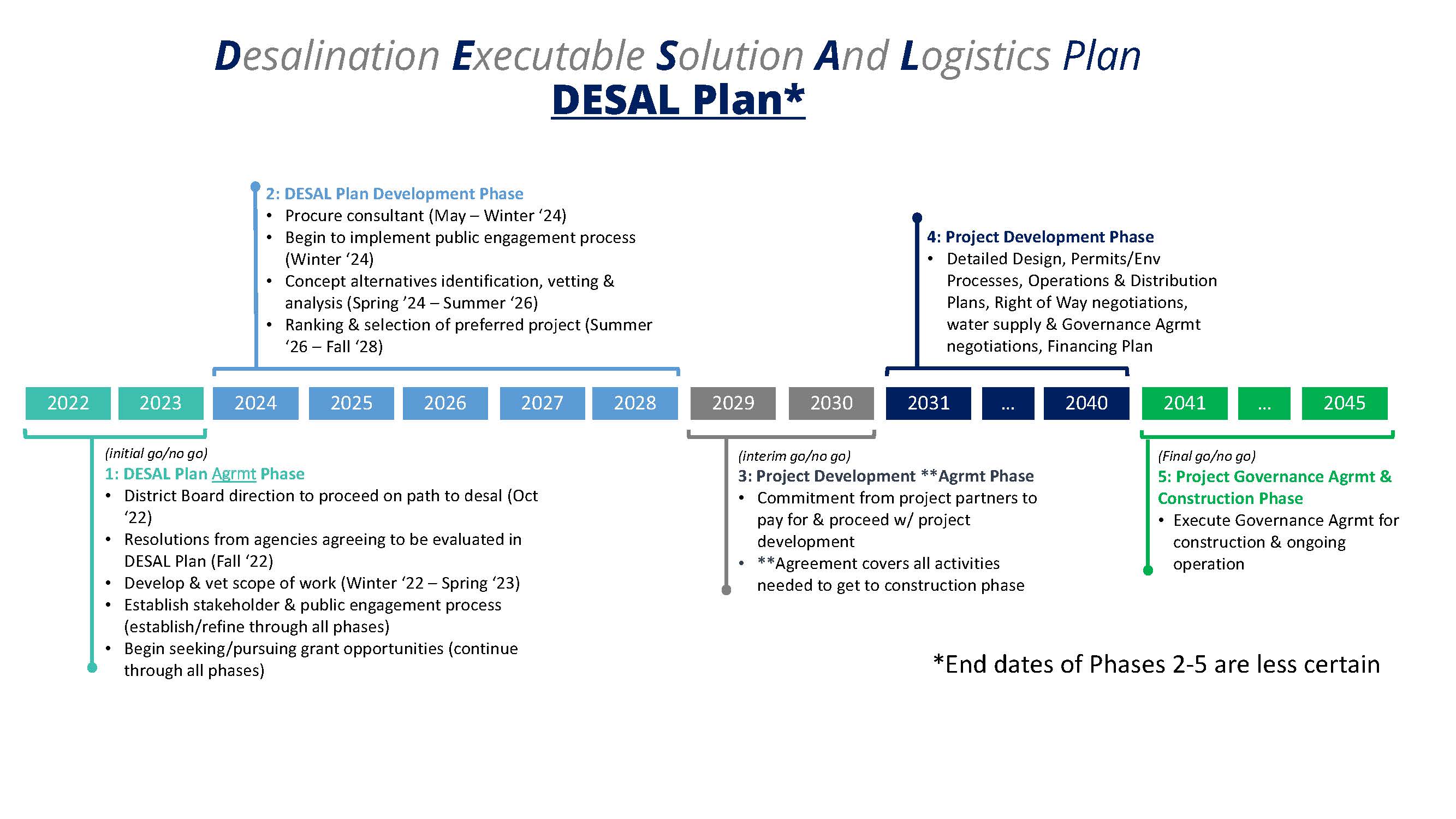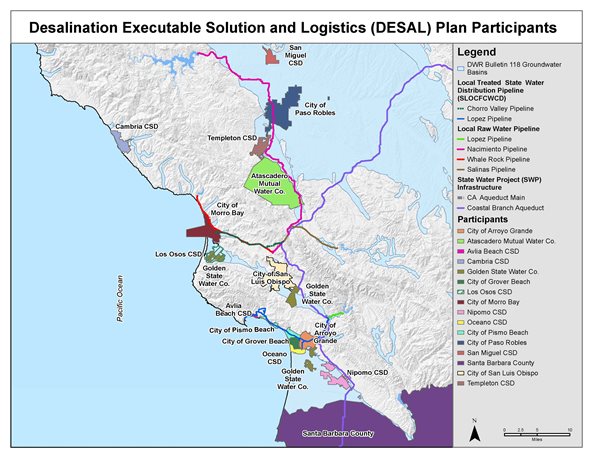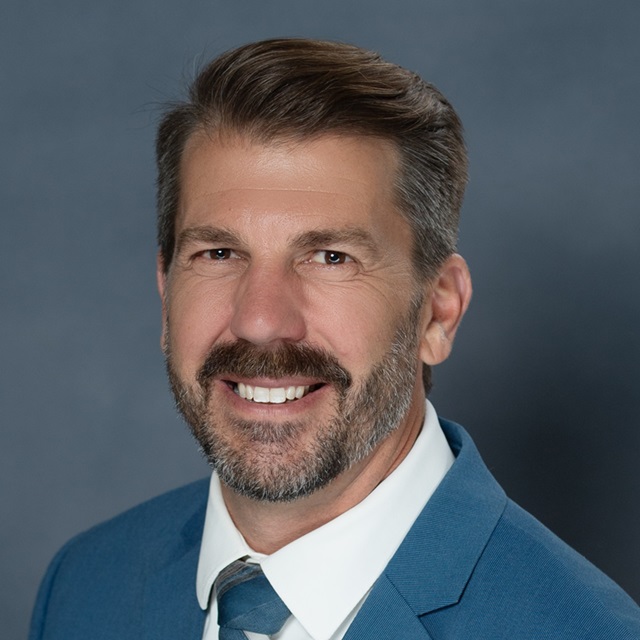Desalination Executable Solution and Logistics Plan (DESAL Plan)
The San Luis Obispo County Flood Control and Water Conservation District (District) is kicking off Phase 1 of a 5-Phase effort to identify and implement a local desalination project. Desalination, the process of removing salt from seawater and/or brackish water to create a freshwater resource, can provide a safe, long-term, drought-proof, and resilient water supply.
Timeline
Desalination projects take time to plan, permit, and construct. Factors that contribute to the feasibility of a desalination project are permitting, funding, community support, and environmental protection. The County has coordinated with the Countywide Water Action Team (CWAT), and informal working group of staff from entities accross the county with water supply planning responsibilities, to create a 5-phase approach to develop a desalination project. Right now, the County is pursuing Phase 1: DESAL Plan, which includes stakeholder engagement, funding procurement, and developing a scope of work.
For a draft timeline and description of the 5-phases, please click on the following figure:
Events and Community Outreach
Recent desalination projects within the state of California have taught us that stakeholder outreach and early engagement are critical to a successful desalination project. Engagement in the early planning phases of the project will allow us to build a broad coalition of supporters, which will be necessary to obtain the required permitting. One of the first steps in developing the DESAL Plan will be establishing a stakeholder and public engagement process, which will then be implemented through all phases.
Updates on the desalination project will be given at Water Resources Advisory Committee (WRAC) meetings. WRAC meetings are open to the public. For meeting dates and locations, please go to www.slocounty.ca.gov/Departments/Public-Works/Committees-Programs/Water-Resources-Advisory-Committee-(WRAC).aspx
Countywide Water Action Team (CWAT) Agency Meetings
- The following agencies have adopted resolutions agreeing to be considered in the DESAL Plan:
- City of Arroyo Grande
- Atascadero Mutual Water Co.
- Avila Beach CSD
- Cambria CSD
- Golden State Water Co.
- City of Grover Beach
- Los Osos CSD
- City of Morro Bay
- Nipomo CSD
- Oceano CSD
- City of Paso Robles
- City of Pismo Beach
- San Miguel CSD
- Santa Barbara County
- City of San Luis Obispo
- Templeton CSD
Join our Mailing List
- Click here to join the County of San Luis Obispo's DESAL Plan mailing list.
FAQs
Desalination is the process of removing salt from water. There are multiple desalination technologies, including thermal distillation, electrodialysis, capacitive deionization, and membrane separation (reverse osmosis). Desalinated water can serve as a new water source to meet the demands placed on existing municipal supply, agricultural/landscape irrigation, groundwater replenishment, and seawater intrusion mitigation.
In the county, existing conditions and future projections indicate that water security is declining as demands increase and available supplies and their reliability decrease.
The County has implemented / planned for water supply strategies including conservation, stormwater capture, Nacimiento Water Project optimization, Lopez Water Project, Salinas Dam transfer and spillway rise, State Water Project and Water Management Tools, recycled water, produced water from oil extraction, cloudseeding, and regional resiliency. These efforts will help extend the County’s water supply, but they are not enough to overcome long-term shortages. Competition for existing water supplies (particularly those that depend on precipitation) in the County and across the state, is anticipated to increase with new regulations related to groundwater/surface water interactions and minimum sustainability thresholds, water quality, environmental flow, and housing directives. Relying on water sourced from precipitation from outside San Luis Obispo County is challenging due to the County’s relative geographic isolation, energy, right-of-way requirements, and fluctuating supply year to year. A new drought-proof, local water supply will be necessary to sustain the population long-term, and with the County’s 90-mile coastline, desalination is a realistic goal.
Efforts for preliminary desalination planning were included in the District’s fiscal year 2022-23 budget where water resiliency was named a top priority. The board authorized staff to proceed with a DESAL Plan on October 18, 2022, and staff will return to the board at a future date (anticipated April 18, 2023) with a proposed scope of work for a consultant and the estimated costs associated with DESAL Plan development. Estimating costs associated with building and maintaining a project and how it will be funded is a part of the DESAL Plan development process.
Grants are, and will continue to be, pursued to offset project costs throughout all DESAL Plan phases. The grant application for the USBR's WaterSMART: Water Recycling and Desalination Planning grant is available here and USBR's anticipated awards, including $548,410 to the County, are listed here.
Although a seawater desalination project has the potential to be situated at a variety of locations along approximately 90-miles of coastline within the County, careful consideration of factors such as appropriate land use, location of sensitive and protective areas (e.g., National Marine Sanctuaries), siting concerns related to the coastal zone, and proximity to power and piping infrastructure would narrow the feasible locations. The project location, size, water production, technology to be used, etc. will be decided during Phase 2.
The best available technology and methods to meet regulations and mitigate environmental impacts will be vetted during Phase 2. There are several technologies available to protect marine life, and it is anticipated that they will continue to evolve during the planning phase along with guidance from the state and regulatory agencies.
County board items related to desalination can be viewed at the links below:
- 1/14/2025: Request to approve and execute contract with Carolo Engineers for DESAL Plan initial phase
- 4/18/2023: Resolution designating the Director of Public Works, or designee, as the authorized representative to prepare, review, approve and file an application and execute agreements for the U.S. Department of Interior Bureau of Reclamation
- 10/18/22: Resolution Authorizing Staff to Proceed with Developing the Desalination Executable Solution and Logistics Plan and Authorize the Director of Public Works, or Designee, to Pursue Grants to Offset Project Costs
- 2/15/22: Presentation by the authors of the Stanford University and Massachusetts Institute of Technology (MIT) study titled, “An Assessment of the Diablo Canyon Nuclear Power Plant for Zero Carbon Electricity, Desalination, and Hydrogen Production.”
- 11/16/21: Review and approve Fiscal Year 2022-23 Budget Goals and Policies (Water Resilience, including desalination, prioritized).
- 3/16/21: Presentation on water supply efforts in San Luis Obispo County.
- 3/22/16: Update of the Diablo Canyon Desalination Project with direction to staff to proceed with project development and coordination work, and request authorization of a corresponding budget adjustment in the amount of $900,000 from San Luis Obispo County Flood Control and Water Conservation District Reserves.
- 8/25/15: Submittal of a Desalination Opportunities Summary Report and recommended direction to staff to proceed on emergency and long-term desalination opportunities.


